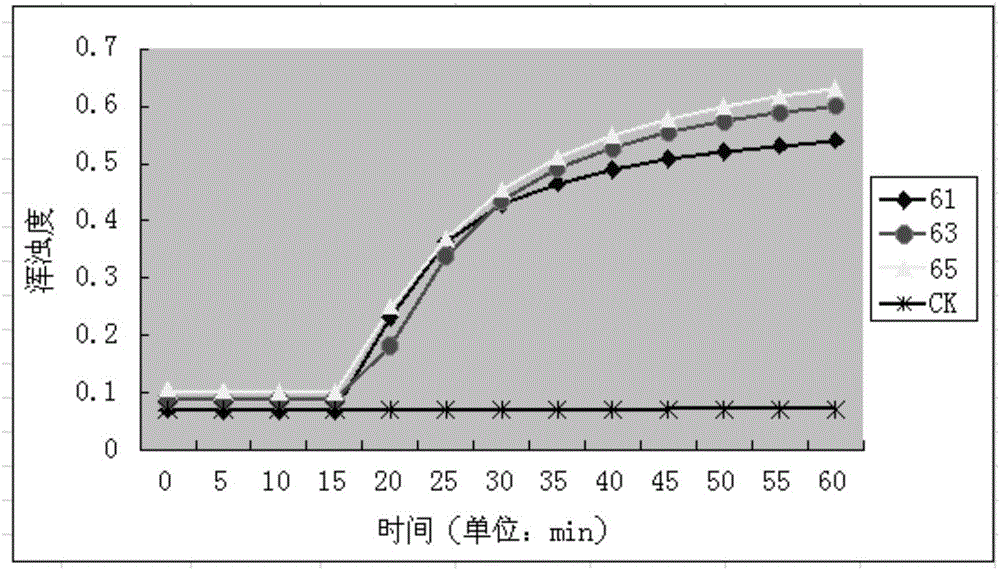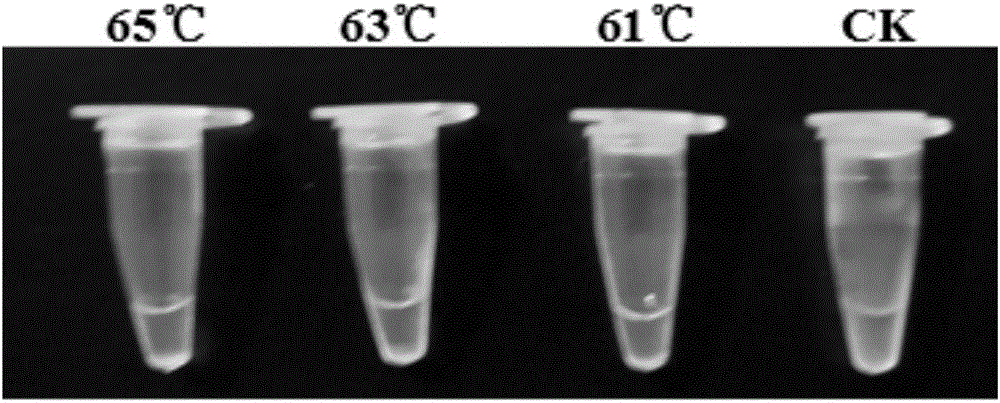RT-LAMP (reverse transcription-loop-mediated isothermal amplification) primers and kit for detecting pepper veinal mottle virus
A RT-LAMP, detection kit technology, applied in DNA/RNA fragments, microorganisms, recombinant DNA technology, etc., can solve the problem of low sensitivity, and achieve the effect of rapid identification, strong professionalism and high sensitivity
- Summary
- Abstract
- Description
- Claims
- Application Information
AI Technical Summary
Problems solved by technology
Method used
Image
Examples
Embodiment 1
[0035] The design of embodiment 1 primer
[0036] According to the capsicum vein mottle virus coat protein (CP) gene sequence registered in GenBank (GenBank sequence accession number: FJ617225), the outer primer pair F3 and B3 and the inner primer pair FIP and BIP were designed. After the design was completed, the primers were listed in the NCBI database. The comparison verification was carried out under the Primer-Blast module, and the following RT-LAMP primer sets were finally selected:
[0037] F3: CTTGAATGGCTTAATGGTTTG;
[0038] B3: CGCTTTCCAATGTACGCT;
[0039] FIP:CTCTTCACCATCAACCATCACCCTGTATAGAAAATGGGACATCGC;
[0040] BIP: ATCCAATTAAGCCATGATTGATTGACCATACTGAAATGCGCCATGA.
Embodiment 2
[0041] The establishment and optimization of embodiment 2 RT-LAMP system
[0042] (1) Experimental materials
[0043] The diseased pepper leaf tissue caused by known pepper vein mottle virus infection and the known healthy pepper leaf tissue were used as materials.
[0044] Capsicum vein mottle virus RT-LAMP detection kit, comprising the following components: RT-LAMP primers designed and synthesized in Example 1; RT-LAMP reaction solution; enzyme solution; nucleic acid fluorescent dye;
[0045] RT-LAMP reaction solution (2×reaction buffer, Rongyan Biotechnology (China) Co., Ltd.) contains the following components: Tris-HCl (pH8.8) 40mM; KCl20mM; MgSO 4 16mM; (NH 4 ) 2 SO 4 20mM; Tween200.2% (w / w); Betaine1.6M; dNTPs each 2.8mM;
[0046] Enzyme solution (Rongyan Biotechnology (China) Co., Ltd.) is a mixed solution of BstDNA polymerase and AMV reverse transcriptase;
[0047] Nucleic acid fluorescent dye (Rongyan Biotechnology (China) Co., Ltd.) is a fluorescent visual detect...
Embodiment 3
[0055] Embodiment 3 Sensitivity experiment to known disease sample detection
[0056] (1) Experimental materials
[0057] Pepper disease-like leaf tissues caused by known pepper vein mottle virus infection and known healthy pepper leaf tissues were used as materials.
[0058] Pepper vein mottle virus RT-LAMP detection kit is the same as in Example 2.
[0059] (2) Experimental method
[0060] The total RNA of the extracted capsicum leaf tissue was divided into 1.0×10 -1 ~10 -8 Concentration gradient dilutions were used as templates for RT-LAMP and ordinary RT-PCR detection respectively, and the detection sensitivities of the two were compared.
[0061] (3) Experimental steps
[0062] (1) Extraction of total RNA from diseased samples: Weigh 0.1g of pepper leaves to be tested into a mortar, grind into a fine powder under liquid nitrogen, transfer the powder to a pre-cooled 1.5mL centrifuge tube quickly, add lmLTrizol Then let stand at room temperature for 10 minutes to full...
PUM
 Login to View More
Login to View More Abstract
Description
Claims
Application Information
 Login to View More
Login to View More - R&D
- Intellectual Property
- Life Sciences
- Materials
- Tech Scout
- Unparalleled Data Quality
- Higher Quality Content
- 60% Fewer Hallucinations
Browse by: Latest US Patents, China's latest patents, Technical Efficacy Thesaurus, Application Domain, Technology Topic, Popular Technical Reports.
© 2025 PatSnap. All rights reserved.Legal|Privacy policy|Modern Slavery Act Transparency Statement|Sitemap|About US| Contact US: help@patsnap.com



